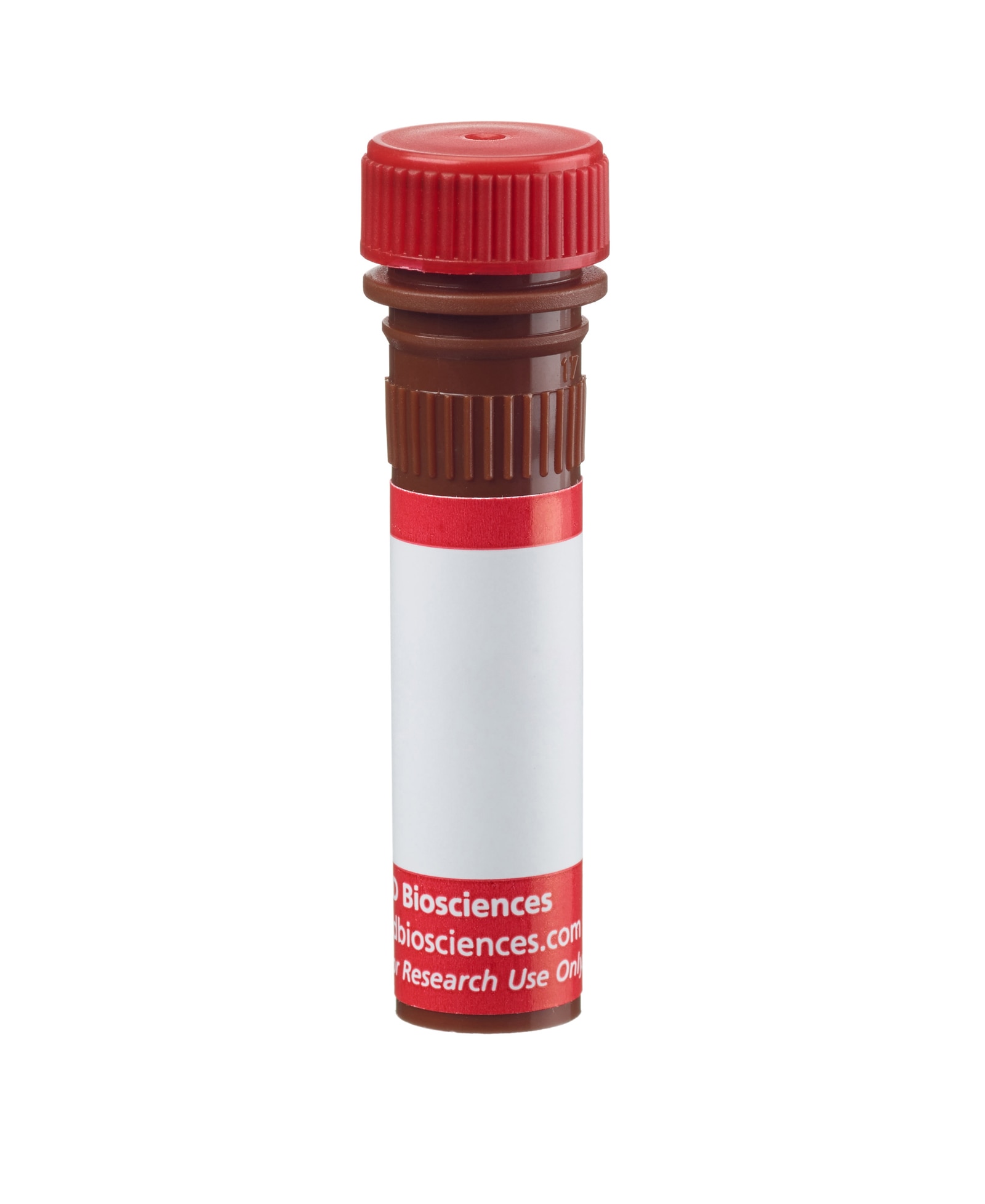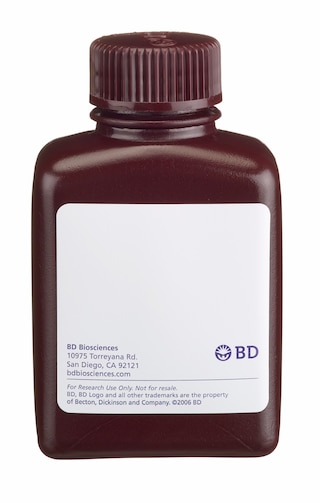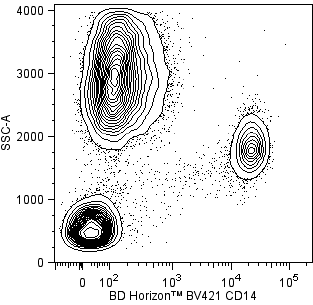-
Your selected country is
Middle East / Africa
- Change country/language
Old Browser
This page has been recently translated and is available in French now.
Looks like you're visiting us from {countryName}.
Would you like to stay on the current country site or be switched to your country?




Two-color flow cytometric analysis of TRAF1 expression in resting and activated human peripheral blood mononuclear cells (PBMCs). Left Plots: Resting PBMCs were freshly isolated by density gradient centrifugation. Right Plots: PBMCs were activated (24 h) in complete tissue culture medium with lipopolysaccharide (LPS; 100 ng/ml). Cells were harvested, fixed with BD Cytofix™ Fixation Buffer (Cat. No. 554655), and then permeabilized with BD Perm/Wash™ Buffer (Cat. No. 554723). The cells were then stained with BD Horizon™ BV421 Mouse Anti-Human CD14 antibody (Cat. No. 565283) and either Alexa Fluor® 647 Rat IgG2a, κ Isotype Control (Cat. No. 557906; Top Plots) or Alexa Fluor® 647 Rat Anti-Human TRAF1 antibody (Cat. No. 566738; Bottom Plots) at 0.25 μg/test. Two-color flow cytometric contour plots showing the correlated expression of TRAF1 (or Ig Isotype control staining) versus CD14 were derived from gated events with the forward and side light-scatter characteristics of intact cells. Flow cytometry and data analysis were performed using a BD LSRFortessa™ Cell Analyzer System and FlowJo™ software. Data shown on this Technical Data Sheet are not lot specific.


BD Pharmingen™ Alexa Fluor® 647 Rat Anti-Human TRAF1

Regulatory Status Legend
Any use of products other than the permitted use without the express written authorization of Becton, Dickinson and Company is strictly prohibited.
Preparation And Storage
Product Notices
- Since applications vary, each investigator should titrate the reagent to obtain optimal results.
- An isotype control should be used at the same concentration as the antibody of interest.
- Caution: Sodium azide yields highly toxic hydrazoic acid under acidic conditions. Dilute azide compounds in running water before discarding to avoid accumulation of potentially explosive deposits in plumbing.
- The Alexa Fluor®, Pacific Blue™, and Cascade Blue® dye antibody conjugates in this product are sold under license from Molecular Probes, Inc. for research use only, excluding use in combination with microarrays, or as analyte specific reagents. The Alexa Fluor® dyes (except for Alexa Fluor® 430), Pacific Blue™ dye, and Cascade Blue® dye are covered by pending and issued patents.
- Alexa Fluor® is a registered trademark of Molecular Probes, Inc., Eugene, OR.
- Alexa Fluor® 647 fluorochrome emission is collected at the same instrument settings as for allophycocyanin (APC).
- For fluorochrome spectra and suitable instrument settings, please refer to our Multicolor Flow Cytometry web page at www.bdbiosciences.com/colors.
- Please refer to www.bdbiosciences.com/us/s/resources for technical protocols.
Companion Products






The 1F3 monoclonal antibody specifically recognizes TNF Receptor-associated factor 1 (TRAF1) which is also known as Epstein-Bar virus-induced protein 6 (EBI6). TRAF1 is a ~46 kDa cytoplasmic protein that is encoded by the TRAF1 gene and belongs to the TRAF family of proteins that serve as signaling adaptors. TRAF1 contains a C-terminal TRAF domain that allows it to interact with the cytoplasmic domains of different members of the TNF Receptor superfamily including TNFR1/CD120a, TNFR2/CD120b, CD30, CD40, and RANK/CD265. These interactions contribute to the activation of MAP kinases (eg, JNK) and transcription factors (eg, NF-κB) that participate in regulating cellular proliferation, differentiation, stress responses, and survival. TRAF1 is expressed in cells derived from various tissues including testis, epidermis, and thymus, and at lower levels by resting leucocytes from secondary lymphoid tissues. Leucocyte TRAF1 expression can be upregulated or downregulated in response to different stimuli including infectious agents, mitogens, lipopolysaccharide (LPS), cytokines and other inflammatory mediators.
Development References (5)
-
Abdul-Sater AA, Edilova MI, Clouthier DL, Mbanwi A, Kremmer E, Watts TH. The signaling adaptor TRAF1 negatively regulates Toll-like receptor signaling and this underlies its role in rheumatic disease. Nat Immunol. 2017; 18(1):26-35. (Clone-specific: Flow cytometry). View Reference
-
Siegler G, Kremmer E, Gonnella R, Niedobitek G. Epstein-Barr virus encoded latent membrane protein 1 (LMP1) and TNF receptor associated factors (TRAF): colocalisation of LMP1 and TRAF1 in primary EBV infection and in EBV associated Hodgkin lymphoma. Mol Pathol. 2003; 56(3):156-161. (Immunogen: Immunofluorescence, Immunohistochemistry, Western blot). View Reference
-
Speiser DE, Lee SY, Wong B, et al. A regulatory role for TRAF1 in antigen-induced apoptosis of T cells. J Exp Med. 1997; 185(10):1777-1783. (Biology). View Reference
-
Wang C, McPherson AJ, Jones RB, et al. Loss of the signaling adaptor TRAF1 causes CD8+ T cell dysregulation during human and murine chronic infection. J Exp Med. 2012; 209(1):77-91. (Clone-specific: Flow cytometry). View Reference
-
Zapata JM, Krajewska M, Krajewski S, et al. TNFR-associated factor family protein expression in normal tissues and lymphoid malignancies. J Immunol. 2000; 165(9):5084-5096. (Biology). View Reference
Please refer to Support Documents for Quality Certificates
Global - Refer to manufacturer's instructions for use and related User Manuals and Technical data sheets before using this products as described
Comparisons, where applicable, are made against older BD Technology, manual methods or are general performance claims. Comparisons are not made against non-BD technologies, unless otherwise noted.
For Research Use Only. Not for use in diagnostic or therapeutic procedures.
Report a Site Issue
This form is intended to help us improve our website experience. For other support, please visit our Contact Us page.